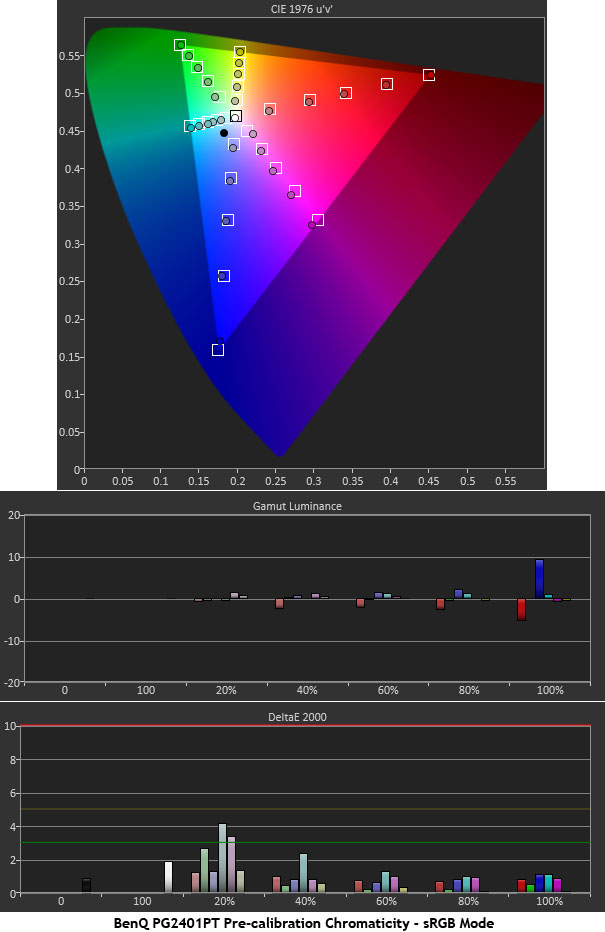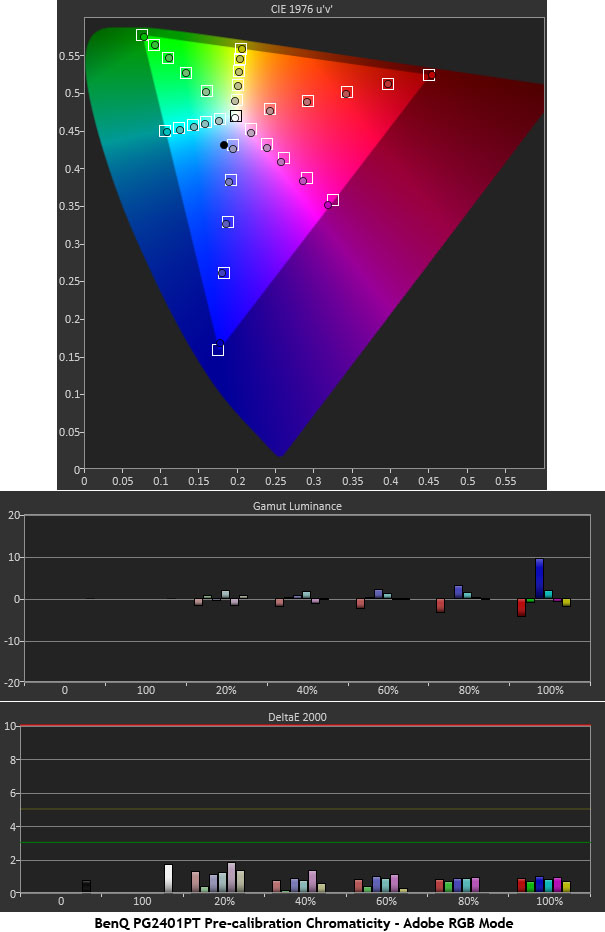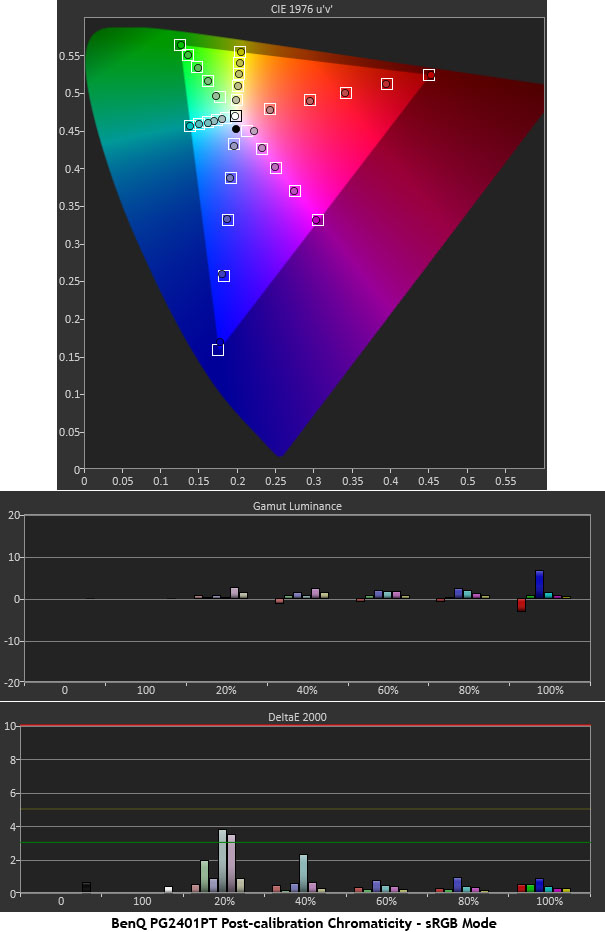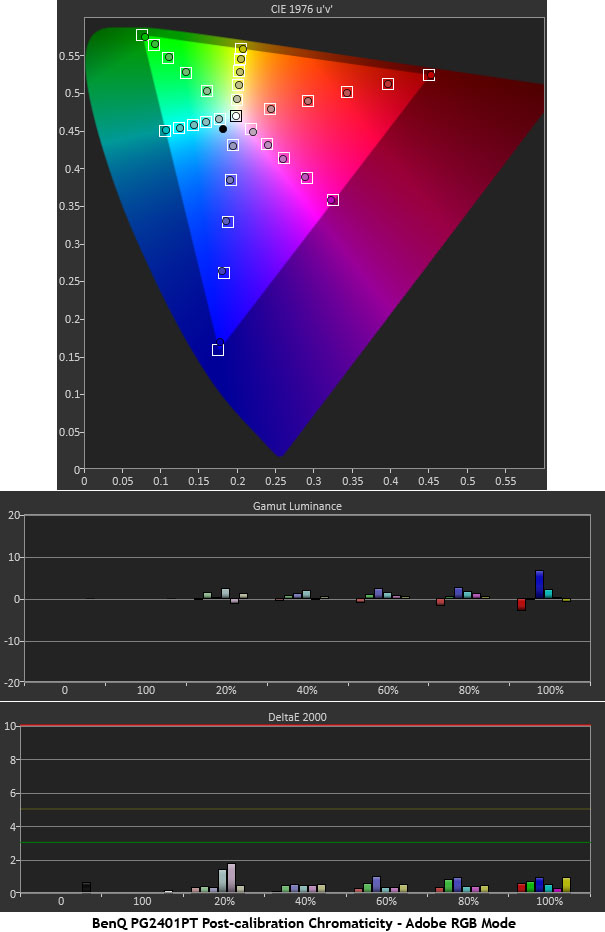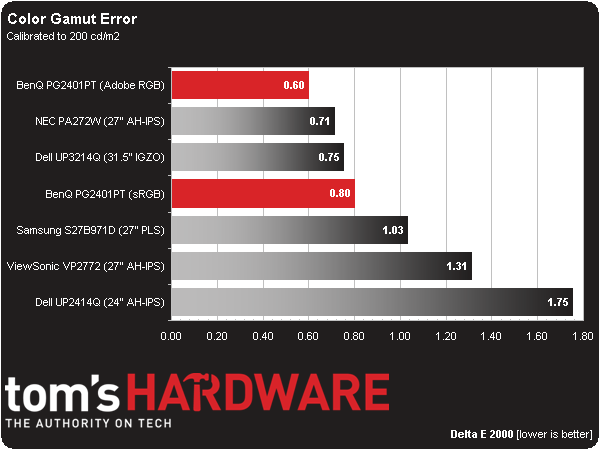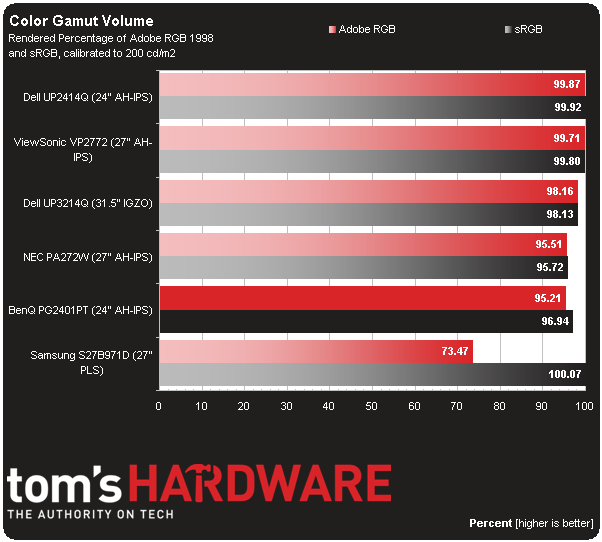BenQ PG2401PT, 24-inch Color Accurate Monitor Review
Photographers and printing pros look for the ultimate accuracy when they choose a monitor. BenQ answers the call with its 24-inch PG2401PT IPS display. It’s industry-certified for color accuracy, even without calibration. Today, we put it to the test.
Results: Color Gamut And Performance
Color gamut is measured using a saturation sweep that samples the six main colors (red, green, blue, cyan, magenta, and yellow) at five saturation levels (20, 40, 60, 80, and 100%), providing a realistic view of color accuracy.
We’ve already established that you can use the preset sRGB and Adobe RGB modes without calibration. There is, however, a slight gain to be had if you do make some adjustments. The first two charts show the PG2401PT in its stock configuration.
Observable issues are minimal. Magenta is a little off in hue and there is over-saturation at the 20-percent level in cyan and magenta. When you get to the edge of the gamut, blue is slightly under-saturated, but its luminance is a little higher, which brings its Delta E down to the proper point. The overall error is a super-low 1.14.
The Adobe RGB chart is even better than the sRGB one. All errors are under two Delta E with a total average of .90. The only thing we’d want to fix is the under-saturated blue primary. BenQ correctly increases the blue luminance to compensate.
Setting up a Custom sRGB mode does make a visible difference on the chart, but not to a naked eye. We managed to reduce the error from 1.14 to .8 Delta E. Basically we took a great result and made the teeniest bit better.
Our gains in the Custom Adobe RGB mode are about the same. We reduced the average error from .9 to .6 Delta E. While we’ve satisfied our tweaker-lust, calibration is probably unnecessary.
Now we return to the comparison group:
Get Tom's Hardware's best news and in-depth reviews, straight to your inbox.
A result of .6 Delta E is the lowest color error we’ve ever recorded from any display in our lab. All of the monitors in the group offer superb accuracy, but the PG2401PT truly does represent perfection. The sRGB result is just behind at .8 Delta E.
Gamut Volume: Adobe RGB 1998 And sRGB
There are basically two categories of displays in use today: those that conform to the sRGB/Rec. 709 standard like HDTVs, and wide-gamut panels that show as much as 100 percent of the Adobe RGB 1998 spec. We use Gamutvision to calculate the gamut volume, based on an ICC profile created from our actual measurements.
Not so long ago, you had to choose the gamut you wanted from a monitor. Adobe RGB displays didn’t have an sRGB option. Newer products now give you that preset. All of the professional screens we’ve tested lately cover both gamuts.
BenQ's PG2401PT comes a little short of 100 percent in both tests due to its slightly under-saturated blue primary. And we weren't able to fix that using the CMS.
Current page: Results: Color Gamut And Performance
Prev Page Results: Grayscale Tracking And Gamma Response Next Page Results: Viewing Angles And Uniformity
Christian Eberle is a Contributing Editor for Tom's Hardware US. He's a veteran reviewer of A/V equipment, specializing in monitors. Christian began his obsession with tech when he built his first PC in 1991, a 286 running DOS 3.0 at a blazing 12MHz. In 2006, he undertook training from the Imaging Science Foundation in video calibration and testing and thus started a passion for precise imaging that persists to this day. He is also a professional musician with a degree from the New England Conservatory as a classical bassoonist which he used to good effect as a performer with the West Point Army Band from 1987 to 2013. He enjoys watching movies and listening to high-end audio in his custom-built home theater and can be seen riding trails near his home on a race-ready ICE VTX recumbent trike. Christian enjoys the endless summer in Florida where he lives with his wife and Chihuahua and plays with orchestras around the state.
-
Xan13x So, maybe it's because I've sort of been out of the game for a while, but back when I got my current monitor, Samsung 27" something or other, 1920x1200 was kind of the standard for a decent monitor. I suppose that's changed? I've had no desire to get a new one since, so again I don't keep up with them, but it seems strange that four years later that resolution/aspect is no more.Reply -
mapesdhs Xan13x, alas it's the result of general consumer supply & demand,Reply
mixed with the convenience for manufacturers of making mostly
1080 screens. When I hunted for a 2560x1600 screen last year,
I was shocked at the prices, because the same thing has happened
at 2560, ie. the market has narrowed in on 1440 height instead of 1600,
so the latter are now expensive (assuming one can find them at all),
eg. the Iiyama XB3070WQS-B1 is about 700 UKP, and the HP Z30i
is more than 1000 UKP.
At the least one positive from all this is that good 1200-height IPS
panels are now much more affordable. My first 1920x1200 IPS was
an HP LP2475W which cost about 450 UKP, but today the Dell U2412M
costs less than half that much (is the Dell better? Well, yes & no,
different feature set, etc., but the screen is nice).
I gave up on finding an affordable IPS 2560x1600, and meanwhile it
was obvious review sites had settled on 1440 height anyway (a few
years ago many sites were still testing wtih 1600 screens, but not
now), so I bought a Dell U2713HM instead which works pretty well,
except for its irritating resolution limitation over HDMI (watchout for
that if you buy a new screen, some models only support their max
res via DVI or DP - the Dell I bought can't do more than 1080 via HDMI).
Ian.
-
martel80 ReplyMost accurate computer display tested on Tom's is a BenQ. Say what!?
In case you didn't know, BenQ is the parent company of AU Optronics, which is one of the largest panel manufactures in the world. Other companies (Samsung, Dell, Apple, etc.) use AUO panels in some of their products. -
knowom 16:10>16:9 for anything other than movies that extra pixel height for gaming is a major difference maker in a competitive MOBA game like LoL among other games. It's too bad cheap 1920x1200 displays got phased out for 1080p same with some of the other now odd ball display resolutions that were once much more common.Reply
